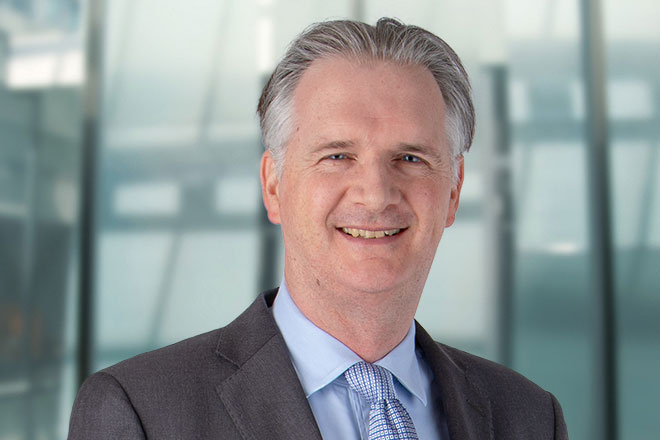‘Peak’ everything?
A number of disruptive trends in the economy are reshaping the investment landscape. In this video summary and article, John Pattullo, Co-Head of Strategic Fixed Income, examines the various peaks and troughs in industries, markets and the economy, which, together with demographic trends and behavioural changes, are contributing to the current low growth, low inflation environment.

8 minute read
Article updated August 2017 (video and article first published September 2016)
In the 1980s I remember writing an economics homework essay about how the world was going to run out of oil by the year 2000 – Marion King Hubbert’s original ‘peak oil’ thesis. Well, predictions are tricky, especially about the future as they say. However, the peak, and indeed trough, thesis seems particularly appropriate to the rather odd world we currently live in.
Peak stuff
 Sure, we have had peak government and peak car but new terms are entering the lexicon: peak stuff, peak globalisation and even peak tech. We in the West actually consume less stuff than we did ten years ago. My garage is full of stuff, which I have no need for even though ‘Aunt Amazon’ keeps knocking at the door (not sure my wife subscribes to the peak stuff philosophy). Most interesting is the significant weakness in global trade, which has been shrinking for a couple of years now – peak globalisation1? Maybe I am not the only one who wants nothing for Christmas; my wife says I’m miserable – I probably am!
Sure, we have had peak government and peak car but new terms are entering the lexicon: peak stuff, peak globalisation and even peak tech. We in the West actually consume less stuff than we did ten years ago. My garage is full of stuff, which I have no need for even though ‘Aunt Amazon’ keeps knocking at the door (not sure my wife subscribes to the peak stuff philosophy). Most interesting is the significant weakness in global trade, which has been shrinking for a couple of years now – peak globalisation1? Maybe I am not the only one who wants nothing for Christmas; my wife says I’m miserable – I probably am!
Peaked or troughed?
It seems everything has peaked out or indeed the opposite; many seem to be going through a trough. Virtually every industry we can think of has too much capacity – airlines, shipping, steel, autos and retail – all with no pricing power. As seasoned readers will know we don’t lend to these industries; if it ‘flies, floats or rolls’ or indeed, if it is one of the three Rs, ‘retail, restaurant or the rag trade’. Take shipping for an example; it is an appalling industry, plagued by capacity build ups and no growth – witness the recent demise of South Korea’s Hanjin Shipping among others.
On a recent holiday to the Seychelles, I was amazed to read in the airport that there are 35 international flights a week into the Seychelles at an average capacity of 40% (the breakeven load factor for airlines – the point at which operations start to make money – is currently around 60-65%). The Arab carriers, among many others, are throwing capacity at this route, increasing their market share and aiming to dominate it. Granted, this is good for cheap holidays as someone else is subsidising the costs. Airbus have recently cut production of their flagship double decker A380 plane (the best solution for 21st Century growth according to Airbus) to only 12 a year – aviation finance bonds anyone? One of my favourite pictures of all time is all those planes rusting in the desert – I wonder when the first A380 will be parked up there?
Enter the ‘sharing’ economy

It was the Ikea executive, Steve Howard, who recently spoke about peak stuff; how it was unlikely they could sell any more furniture as everybody has enough already. This strikes a chord with us and seems hugely relevant to the sharing economy (see Swap shop and the sharing economy). The average car only moves 4% of its life. So in the future we will need less cars and will simply be sharing them (arguably US car production is peaking out at the moment).
Airbnb could hugely lower the need for extra hotel rooms as we simply share existing houses; peak RevPAR2? The effects could be hugely deflationary. Just look at the effect Uber is having on London private hire firm Addison Lee’s profitability, where they have recently fallen by two thirds.
So we can add to our list peak taxi fare, peak hotel room and peak car ownership.
Growth troughs, asset inflation peaks
Post the Global Financial Crisis, economic growth has been pitiful. Economic growth, inflation, defaults, volatility, productivity, trade, credit demand and bond yields all seem to have troughed while asset inflation peaks (S&P 500, NASDAQ indices) on an almost daily basis. There are a number of complementary theories to explain this.
Jenna and I have spoken about Richard Koo’s balance sheet recession view of the world for over five years now. This is where individuals or corporates do not want to borrow when interest rates are lowered, as they just want to reduce their debt – peak credit perhaps? Larry Summers’ secular stagnation is a similar view but emphasises excess savings as the cause of the lack of aggregate demand.
Demographics or deflationary effects of technology?
More recently demographics have been getting another airing – not enough producers/consumers and too many older savers – those dependency ratios just keep getting worse.
Other theories focus on the chronic lack of productivity and the deflationary effects of technology and the shared economy. One such technology is artificial intelligence. It has been around for years, but more recently advances in machine learning, sensor technology, and computer power has meant new generation software and hardware robots are being applied across almost every industry, replacing humans and driving down operational costs.
Indeed in our very own asset management industry we’re seeing the creeping use of A.I. to do varying parts of the fund management process, from risk analysis to asset allocation to using algorithms to pick stocks. It is enabling disruptive start-ups – known as robo-advisors – to strip-out human costs and charge much lower fees, pressuring fees from ‘active’ managers and driving a recent wave of mergers and consolidation (this year Henderson merged with American firm Janus Capital). Could this be peak active fund management? We hope not.
Behavioural changes matter

But more importantly, we think the behavioural change in the consumer is significant. My colleague, Arjun Bhandari, has highlighted the reduced desire and ability for millennials to consume as this demographic would rather purchase experiences than consumer durables (see Creative disruption: a shifting investment backdrop)
Behaviours vary by generation but also by culture. We heard a story from a respected Japanese economist the other day – if you go to the consumer electronics district of Tokyo you will find canny Japanese consumers buying cheap ‘value’ Chinese made rice cookers. Whereas the ‘bling3‘ Chinese tourists tend to buy overpriced, over engineered Japanese rice cookers. It is not until we have a change in consuming behaviour, that we may have the remotest chance of getting out of the current economic malaise.
Did we mention ‘lower for even longer’?
We are sympathetic to all of the above theories. We have talked about ‘lower for even longer’ for years but now it is getting much more mainstream acceptance among our client base. In this regard, in recent years we have favoured quality, long dated (higher duration), large cap, non cyclical corporate bonds over high yield bonds. This has worked very well (see Buy investment grade, wear diamonds), whereas some of our competitors are still in the reflation camp.
In a well-behaved world, business cycles follow the pattern of growth, boom, recession and recovery. In the boom phase excess demand leads to rising inflation, which in turn translates into higher interest rates to dampen the demand (hurting bond returns). The current prolonged period of recovery has naturally led to reflation theories. But such theories miss the important fact that the economy has now moved on from an excess in demand to an excess in supply, making the prospects of inflation even more remote. Indeed, the lack of inflation is a global problem. It does not feel temporary or idiosyncratic to us. But the Fed, run by labour market academic economists continue to place too much emphasis on the broken Phillips curve analysis (see Broken curves: are misguided inflation measures leading to policy mistakes?).
Thus the current consensus that the boom in bonds is soon to go out with a bang, may actually turn out to be only a whimper. In reality, however, it is impossible to predict.
Meanwhile, in a little corner of the fixed income market…
The current economic environment has been a great time to be invested in corporate bonds. Central bank quantitative easing programmes, and more lately bond purchases by the European Central Bank and the Bank of England have made the bond drought even more severe (see Jenna Barnard’s Conservative stance of European corporates = supportive for bond investors). Peak bond maybe, but we are not convinced.
Remember, a golden rule of investing is ‘don’t fight the Fed’ and another is ‘respect the technicals4‘. Today’s bond markets are technical, technical and technical. If anything we prefer a more credit sensitive market, one that is more focused on the likelihood of company defaults and future earnings, but hey, who’s complaining?
We continue to like large reliable lower end investment grade and top end high yield corporate bonds, in our efforts to deliver a reliable income stream for our investors.
1.The tide of globalisation is turning, Martin Wolf, Financial Times, 6 September 2016
2. RevPAR = revenue per available room
3. Refers to the propensity of Chinese consumers to buy luxury brands
4. Supply/demand and investor positioning (among other causes) influencing markets rather than fundamentals such as economic growth or corporate health
Investment article
These are the views of the author at the time of publication and may differ from the views of other individuals/teams at Janus Henderson Investors. References made to individual securities do not constitute a recommendation to buy, sell or hold any security, investment strategy or market sector, and should not be assumed to be profitable. Janus Henderson Investors, its affiliated advisor, or its employees, may have a position in the securities mentioned.
Past performance does not predict future returns. The value of an investment and the income from it can fall as well as rise and you may not get back the amount originally invested.
The information in this article does not qualify as an investment recommendation.
There is no guarantee that past trends will continue, or forecasts will be realised.
Marketing Communication.
Important information
Please read the following important information regarding funds related to this article.
- An issuer of a bond (or money market instrument) may become unable or unwilling to pay interest or repay capital to the Fund. If this happens or the market perceives this may happen, the value of the bond will fall.
- When interest rates rise (or fall), the prices of different securities will be affected differently. In particular, bond values generally fall when interest rates rise (or are expected to rise). This risk is typically greater the longer the maturity of a bond investment.
- The Fund invests in high yield (non-investment grade) bonds and while these generally offer higher rates of interest than investment grade bonds, they are more speculative and more sensitive to adverse changes in market conditions.
- If a Fund has a high exposure to a particular country or geographical region it carries a higher level of risk than a Fund which is more broadly diversified.
- The Fund may use derivatives to help achieve its investment objective. This can result in leverage (higher levels of debt), which can magnify an investment outcome. Gains or losses to the Fund may therefore be greater than the cost of the derivative. Derivatives also introduce other risks, in particular, that a derivative counterparty may not meet its contractual obligations.
- When the Fund, or a share/unit class, seeks to mitigate exchange rate movements of a currency relative to the base currency (hedge), the hedging strategy itself may positively or negatively impact the value of the Fund due to differences in short-term interest rates between the currencies.
- Securities within the Fund could become hard to value or to sell at a desired time and price, especially in extreme market conditions when asset prices may be falling, increasing the risk of investment losses.
- Some or all of the ongoing charges may be taken from capital, which may erode capital or reduce potential for capital growth.
- CoCos can fall sharply in value if the financial strength of an issuer weakens and a predetermined trigger event causes the bonds to be converted into shares/units of the issuer or to be partly or wholly written off.
- The Fund could lose money if a counterparty with which the Fund trades becomes unwilling or unable to meet its obligations, or as a result of failure or delay in operational processes or the failure of a third party provider.
- When interest rates rise (or fall), the prices of different bonds will be affected differently. In particular, bond prices generally fall when interest rates rise or are expected to rise. This is especially true for bonds with a higher sensitivity to interest rate changes. A material portion of the fund may be invested in such bonds (or bond derivatives), so rising interest rates may have a negative impact on fund returns.
Specific risks
- An issuer of a bond (or money market instrument) may become unable or unwilling to pay interest or repay capital to the Fund. If this happens or the market perceives this may happen, the value of the bond will fall.
- When interest rates rise (or fall), the prices of different securities will be affected differently. In particular, bond values generally fall when interest rates rise (or are expected to rise). This risk is typically greater the longer the maturity of a bond investment.
- The Fund invests in high yield (non-investment grade) bonds and while these generally offer higher rates of interest than investment grade bonds, they are more speculative and more sensitive to adverse changes in market conditions.
- The Fund may use derivatives to help achieve its investment objective. This can result in leverage (higher levels of debt), which can magnify an investment outcome. Gains or losses to the Fund may therefore be greater than the cost of the derivative. Derivatives also introduce other risks, in particular, that a derivative counterparty may not meet its contractual obligations.
- When the Fund, or a share/unit class, seeks to mitigate exchange rate movements of a currency relative to the base currency (hedge), the hedging strategy itself may positively or negatively impact the value of the Fund due to differences in short-term interest rates between the currencies.
- Securities within the Fund could become hard to value or to sell at a desired time and price, especially in extreme market conditions when asset prices may be falling, increasing the risk of investment losses.
- Some or all of the ongoing charges may be taken from capital, which may erode capital or reduce potential for capital growth.
- CoCos can fall sharply in value if the financial strength of an issuer weakens and a predetermined trigger event causes the bonds to be converted into shares/units of the issuer or to be partly or wholly written off.
- The Fund could lose money if a counterparty with which the Fund trades becomes unwilling or unable to meet its obligations, or as a result of failure or delay in operational processes or the failure of a third party provider.
- When interest rates rise (or fall), the prices of different bonds will be affected differently. In particular, bond prices generally fall when interest rates rise or are expected to rise. This is especially true for bonds with a higher sensitivity to interest rate changes. A material portion of the fund may be invested in such bonds (or bond derivatives), so rising interest rates may have a negative impact on fund returns.